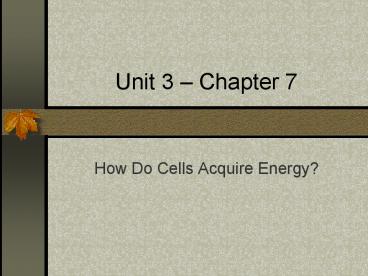Unit 3 - PowerPoint PPT Presentation
1 / 31
Title:
Unit 3
Description:
Unit 3 Chapter 7 How Do Cells Acquire Energy? Light energy Chemical energy E. Light Energy - has characteristics of both waves and bundles (photons) - Waves ... – PowerPoint PPT presentation
Number of Views:36
Avg rating:3.0/5.0
Title: Unit 3
1
Unit 3 Chapter 7
- How Do Cells Acquire Energy?
2
I. Sunlight and Survival
- Autotrophs self-nourishing
- Photoautotrophs sunlight captured to drive
metabolic reactions - Photosynthesis
- Light Energy ? Chemical Energy
- Heterotrophs other organisms as source of
energy - Chemosynthesis energy from inorganic molecules
- Hydrothermal Vents
3
Light energy Chemical energy
Photosynthesis
4
E. Light Energy
- - has characteristics of both waves and bundles
(photons) - - Waves the electromagnetic spectrum
5
(No Transcript)
6
II. Photosynthesis Overview
7
A. Chloroplast structure
- 20 to 100/photosynthetic plant cell
- 1. Inner and outer membranes
- 2. Intermembrane space
- 3. Stroma
- 4. Granum (grana is plural) stack of membrane
bound sacs called thylakoids - a. Thylakoids
- - Thylakoid membrane
- - Thylakoid space
8
(No Transcript)
9
B. Three major steps of photosynthesis
- 3. Convert unstable chemical bonds to stable
chemical bonds (G3P and glucose) (Calvin Cycle)
- 1. Absorb light energy (photosynthetic pigments)
- 2. Convert light energy to unstable chemical
bonds (ATP and NADPH)
These are the light independent reactions that
take place in the stroma
These are light dependent reactions that take
place in the thylakoids
10
C. Key Concepts
- Photosynthesis is the pathway by which carbon and
energy enter the web of life - In plants, photosynthesis takes place in
chloroplasts - Photosynthesis is summarized this way
- 12H20 6CO2 ---gt 602 C6H12O6 6H2O
- ATP supplies energy for reactions which
synthesize glucose from CO2 and water
11
D. Photosynthetic pigments
- 1. Absorption spectrum vs. Action spectrum
- (absorbed wavelengths) (performance)
12
- 2. Chlorophyll a
- Why green?
13
3. Englemanns Observational Test
- Oxygen-requiring bacteria congregated where
oxygen was being produced by algae
14
- 4. Accessory pigments
- Purpose to transfer energy to chlorophyll a
- 1. Chlorophyll b 3. Phycobilins
- 2. Carotenoids 4. Anthocyanins
15
- 5. Chlorophyll structure
- a. Porphyrin ring with Mg at center
- -absorbs light energy
- b. Hydrocarbon chain tail
- -anchors molecules in thylakoid membrane
16
- 6. Role of chlorophyll a
Ground state
Chl a
light energy
2 H
H2O electrons
½ O2
Chl
Chl
Excited state
Charged state
electrons to NADP
17
III. Noncyclic Photophosphorylation(Light
Dependent Reactions)
18
(No Transcript)
19
(No Transcript)
20
(No Transcript)
21
Photolysis
22
(No Transcript)
23
(No Transcript)
24
Non Cyclic Video Clip
25
IV. Cyclic Photophosphorylation(variation of
Light Dependent Reactions)
26
(No Transcript)
27
V. Calvin-Benson Cycle
- Occurs in the stroma
- Called light-independent reactions
- Called carbon fixation
- Forms stable bonds from energy in NADPH and ATP
28
(No Transcript)
29
IX. Other forms of carbon fixation
- A. Photorespiration
- 1. Under hot,dry conditions stomata close to
prevent dehydration - 2. In C3 plants the CO2 levels drop, causing
rubisco to use O2 - 3. No ATP produced, 2-carbon compounds wasted
- B. C4 plants have a way to overcome
photorespiration - 1. Calvin cycle in bundle-sheath cells
- 2. CO2 pumped into bundle-sheath cells from
mesophyll cells at a cost of ATP - 3. Corn, sugarcane, crab grass
30
(No Transcript)
31
- C. CAM plants
- 1. Plants living in arid conditions (desert)
- 2. Stomata are closed during day to prevent
water loss - 3. Therefore during the night, CO2 is taken in
and used to make organic acids, malate (R-COOH) - 4. During day CO2 is released from organic acid
to supply Calvin cycle for carbon fixation - 5. Cactus, pineapple































